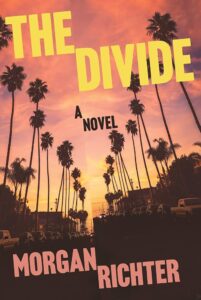I love the thrill of reading a mystery that initially seems grounded in reality, only to find speculative elements drifting in around the edges. While I also appreciate books that smash together two disparate genres, like a cozy mystery set on an alien planet or a spy thriller set in a dystopian future, here I’m talking about something subtler: books in which two genres caress, not collide. Instead of fundamentally shaping the story, the speculative elements merely insert a dab of the unexpected into the everyday.
At the start, my neo-noir thriller The Divide seems steeped in the down-to-earth setting of present-day Los Angeles. But as hard-luck actress-turned-psychic Jenny St. John unearths the dark secrets of her past while searching for her missing doppelgänger, things get a little… weird. I drew inspiration for The Divide from books like the ones below, all of which are mostly anchored in the real world, yet aren’t afraid to drift into uncharted waters.
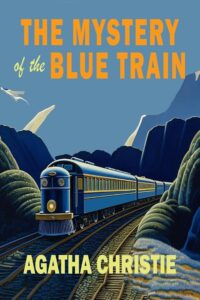
The Mystery of the Blue Train, Agatha Christie
Ask a mystery buff to pick their favorite of the two Agatha Christie mysteries in which Hercule Poirot happens to be aboard a train while one of his fellow passengers is brutally slaughtered, and they’ll likely choose The Murder on the Orient Express. I’ll make the case for 1928’s The Mystery of the Blue Train, which, while less widely read, possesses one cool element that Orient Express lacks: it features a surprise appearance from a ghost. After an heiress is murdered while traveling to meet her lover, Poirot steps in to investigate. He’s aided by the attractive and perceptive Katherine Grey, a traveler whose path had briefly yet meaningfully crossed with the victim’s. Late in the story, while being courted by a charming young man with close ties to the investigation, Katherine becomes aware of a spectral presence hovering beside her. After Poirot unmasks the killer, Katherine realizes she’d been visited by the spirit of the slain woman, who’d attempted to warn her that her prospective suitor was a murderer.
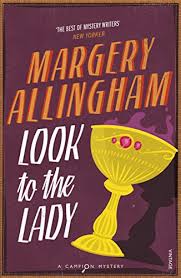
Look to the Lady, Margery Allingham
Look to the Lady, from 1931, is the third mystery to feature Margery Allingham’s gentleman detective, the eccentric Albert Campion. Here, he’s working to stop the planned theft of a priceless religious relic, a Holy Grail-esque chalice kept safe for centuries within a doorless room in an impregnable tower. Despite Campion’s best efforts, the thief manages to penetrate the fortress, though she meets a grim fate before she can abscond with the chalice, which is guarded by the armor-clad skeleton of a long-dead soldier. The cause of the thief’s death is left ambiguous: while it’s possible she was merely startled by the skeleton and fell from the tower, evidence suggests the dead soldier briefly returned to life to defend its sacred treasure.

Fear for Miss Betony, Dorothy Bowers
In Fear for Miss Betony, Dorothy Bowers’s twist-filled mystery from 1940, retired governess Emma Betony is rescued from poverty by one of her now-grown former charges, who hires her as an instructor at a boarding school. Soon after settling into her new position, Miss Betony finds she’s been recruited to play a starring role in a murderous conspiracy. A key spot of villainy is provided by a devil-worshiping fortuneteller known as the Great Ambrosio. While sinister and deceitful, the Great Ambrosio is no fraud: even as he tries to manipulate Miss Betony by telling her a series of lies disguised as missives from an unearthly realm, his psychic abilities force him to foretell her inevitable triumph over evil.

Touch Not the Cat, Mary Stewart
In Mary Stewart’s Touch Not the Cat, from 1976, Bryony returns to her childhood home in the wake of her father’s sudden death, only to find he was likely murdered by one of her three handsome and ruthless second cousins. Complicating matters is Bryony’s long-standing telepathic bond with one of these cousins, a bond that has gradually turned romantic. Their psychic link is powerful yet nebulous: while Bryony and her cousin are able to exchange telepathic messages across great distances, Bryony is uncertain as to which cousin shares her bond—or whether that cousin, whom she regards as her soulmate even though she doesn’t know his exact identity, is also her father’s killer.

Claire DeWitt and the City of the Dead, Sara Gran
Sara Gran has written three offbeat mysteries featuring Claire DeWitt, a chaotic yet confident private eye who eschews standard investigative techniques in favor of a vibes-based approach. In her first outing, 2011’s Claire DeWitt and the City of the Dead, Claire stumbles around Katrina-ravaged New Orleans in search of a public defender who vanished in the wake of the hurricane. Claire prefers divination to detection: she makes deductions based on her interpretation of the I Ching, and she reads fingerprints left at crime scenes like a palmist reads palms. She eventually solves the case via her surreal prophetic dreams, which may be nothing more than drug-induced hallucinations: a tortured soul with a history of mental breakdowns, Claire is also a hardcore user of any illicit substance she can find.
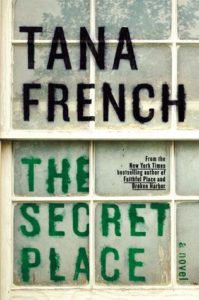
The Secret Place, Tana French
When detectives reopen the unsolved murder of a teen boy at a boarding school in Tana French’s fifth novel, 2014’s The Secret Place, their suspicions crystallize around a tight-knit quartet of friends who have communally developed what seems like a mild form of telekinesis. It’s a party trick: the girls can move small objects and turn lights on and off with nothing more than a focused thought. This seemingly benign bit of magic is rooted in something bigger, deeper, and darker, in ways most of the girls will never understand, even as it quietly turns one of them into a killer.
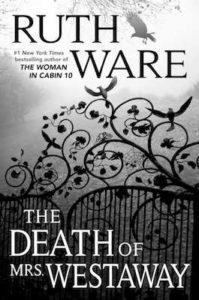
The Death of Mrs. Westaway, Ruth Ware
In Ruth Ware’s 2018 thriller The Death of Mrs. Westaway, young Harriet—Hal to her friends—struggles to make ends meet as a boardwalk psychic, reading tarot cards for tourists in a seaside town. Desperate for cash, she stakes a false claim to an inheritance after she’s mistaken for the long-lost granddaughter of the recently-deceased Mrs. Westaway. Hal’s impulsive act of deception draws the wrath of the dead woman’s offspring, one of whom would kill to protect long-buried family secrets. Throughout the novel, Hal remains adamant that her psychic abilities are nonexistent; she’s certain her eerily accurate tarot readings are nothing more than shrewd guesses and dumb luck. As much as she denies it, though, the truth soon becomes obvious: with the aid of her cards, Hal has an otherworldly ability to predict the future.
***


